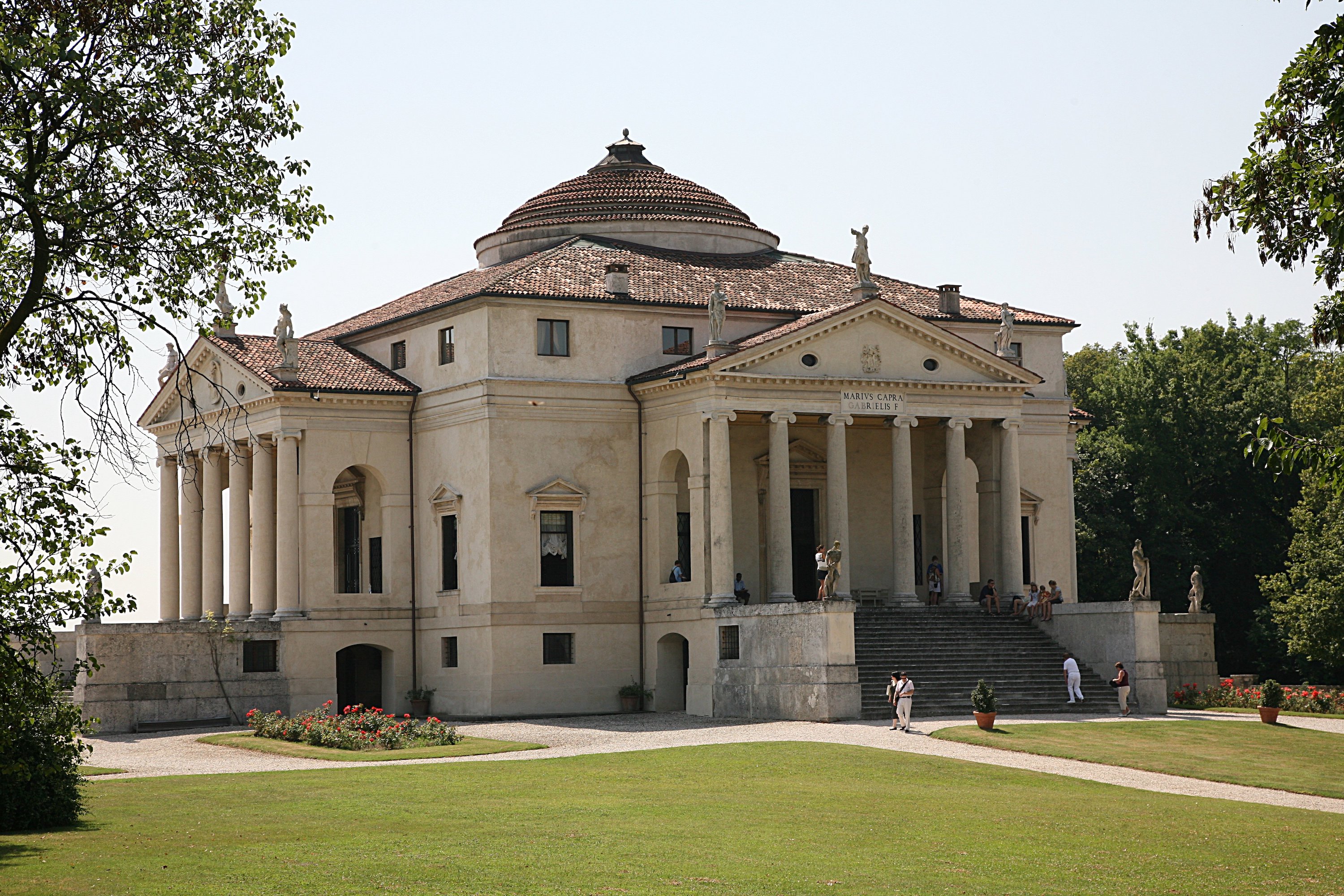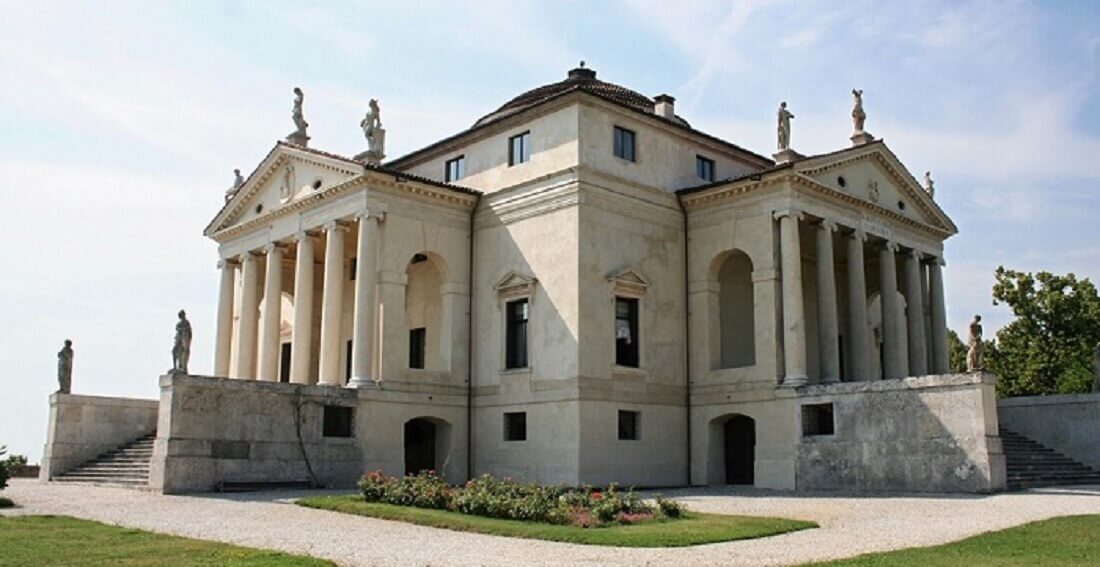:max_bytes(150000):strip_icc()/SanGiorgioMaggiore-500045137-56aaddc65f9b58b7d0090875.jpg)
Andrea Palladio and Renaissance Architecture
Andrea Palladio, Baths of Trajan, Rome: elevations and sections. 1570s, RIBA Collections. About the drawings. Andrea Palladio was a hugely influential Italian architect of the 16 th century. His projects in Venice and the surrounding region set new standards in design and redefined the potential of the artform, combining the lessons of the.

A Palladian Villa in Italy (Published 2017) Villas in italy, Andrea
10 September 2015 Library of Congress Design for US Capitol, Washington DC - by William Thornton, 1793-1800 By Paul Kerley BBC News Magazine Andrea Palladio - an Italian who lived 500 years ago.

Architectural Specimen of Palladio's Villa Rotunda located close to
Updated on July 09, 2019 Andrea Palladio (born November 30, 1508 in Padua, Italy) transformed architecture not only during his lifetime, but his reinterpreted Classical stylings were imitated from the 18th century until today.

Villa Cornaro, A Palladian Villa in Venice This Is Glamorous
Andrea Palladio (1508-1580 CE) was an Italian Renaissance architect most famous for the villas he designed in and around Vicenza and two large churches in Venice. Palladio blended elements of classical architecture, particularly the orders, to create harmonious buildings and was so successful that he became the foremost architect in northern Italy.He also wrote a hugely influential work on.

Andrea Palladio (Italian architect) Images Britannica Neoclassical
William Kent Richard Boyle, 3rd earl of Burlington (Show more) See all related content → Palladianism, style of architecture based on the writings and buildings of the humanist and theorist from Vicenza, Andrea Palladio (1508-80), perhaps the greatest architect of the latter 16th century and certainly the most influential.

PALLANDIANISM architecture characteristics Palladio (Andrea di Pietro
Andrea Palladio ( / pəˈlɑːdioʊ / pə-LAH-dee-oh; Italian: [anˈdrɛːa palˈlaːdjo]; 30 November 1508 - 19 August 1580) was an Italian Renaissance architect active in the Venetian Republic.
architect design™ Palladio in Vicenza setting the course of Western
The theatre was the final design by the Italian Renaissance architect Andrea Palladio and was not completed until after his death. The trompe-l'œil onstage scenery, designed by Vincenzo Scamozzi, to give the appearance of long streets receding to a distant horizon, was installed in 1585 for the very first performance held in the theatre, and.

Villa Chiericati Andrea palladio, Italian villa, Italian architecture
A villa with a superimposed portico, from Book IV of Palladio's I quattro libri dell'architettura, in an English translation published in London, 1736 Plan for Palladio's Villa La Rotonda (c. 1565) - features of the house were incorporated in numerous Palladian-style houses throughout Europe over the following centuries.. Palladian architecture is a European architectural style derived from.

Villa 'La Rotonda' by Palladio (Illustration) World History Encyclopedia
I quattro libri dell'architettura (The Four Books of Architecture) is a treatise on architecture by the architect Andrea Palladio (1508-1580), written in Italian.It was first published in four volumes in 1570 in Venice, illustrated with woodcuts after the author's own drawings.It has been reprinted and translated many times, often in single-volume format.

The 25+ best Villa palladio ideas on Pinterest Andrea palladio
By Dr. Jimena Berzal de Dios Andrea Palladio with modifications by Vicenzo Scamozzi, Villa Rotonda (formerly Villa Capra), near Vicenza, Italy, 1566-1590s (photo: Nico Brooks) Looking back and looking forward At the top of a hill in northern Italy, not far from Venice, stands a majestic villa.

Palladian Villas splendid architecture in the countryside
It featured a design for his pioneering house at Wanstead, Essex, which incorporated all the key Palladian features: a focus on symmetry, proportion and balance, with one side of the building a mirror image of the other; the use of temple fronts (a pediment supported by Corinthian columns or pilasters) and large tripartite Venetian windows.
architect design™ Palladio's Villa Rotonda IN PERSON
Such was the compelling nature of their design that, after Palladio's death in 1580, British architects began to create buildings - from modest working-class terraces to magisterial country houses.

palladio villa rotonda Architecture, Andrea palladio, Architecture design
His designs for palaces (palazzi) and villas, notably the Villa Rotonda (1550-51) near Vicenza, and his treatise I quattro libri dell'architettura (1570; The Four Books of Architecture) made him one of the most influential figures in Western architecture. Early life and works

palladio Villa, Architettura, Andrea palladio
This design provided an ideal model for the sophisticated and highly academic classical style typical of the interior of the mid-eighteenth-century English country house. Palladio's majestic columns and pilasters, pedimented doors, and chimney pieces were carefully imitated to create the much sought after effect of ancient grandeur.

Palladio Villa Valmarana Lisiera (VicenzaItaly) Andrea palladio
This is a Classical style, named after the Italian Renaissance architect Andrea Palladio (1508-1580) whose work and ideas had a profound influence on European architecture from the early 17th century to the present day. Palladio re-interpreted Roman architecture for contemporary use and published his ideas in 'I Quattro Libri dell.

Architect Andrea Palladio Renaissance architecture, Andrea palladio
Andrea Palladio is the only architect who has given his name to a style - one that is still in use around the world after nearly 500 years. From the US Capitol to a 21st century Somerset cowshed.